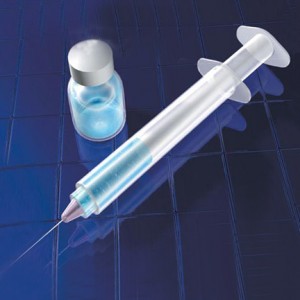 Between the 2 vaccines now available for protection against human papilloma virus (HPV), the quadrivalent vaccine may have an advantage over the bivalent vaccine with respect to costs and quality of life, but the bivalent vaccine may prevent more deaths from cervical cancer, according to new research.
Between the 2 vaccines now available for protection against human papilloma virus (HPV), the quadrivalent vaccine may have an advantage over the bivalent vaccine with respect to costs and quality of life, but the bivalent vaccine may prevent more deaths from cervical cancer, according to new research.
Mark Jit, PhD, MPH, a mathematical modeler from the Health Protection Agency in London, United Kingdom, and colleagues published their findings online September 27 in the BMJ.
As described in the article, the HPV bivalent vaccine (Cervarix, GlaxoSmithKline) targets HPV types 16 and 18, which are estimated to cause more than 70% of cervical cancer cases worldwide. In contrast, in addition to HPV types 16 and 18, the quadrivalent vaccine (Gardasil, Merck) also targets HPV types 6 and 11, to which anogenital warts and recurrent respiratory papillomatoses are attributed.
In 2008, the UK government selected the bivalent vaccine for protection against HPV based on a previous analysis led by the same authors, indicating that the bivalent vaccine would have to be £15 to £23 cheaper per dose to be as cost-effective as the quadrivalent vaccine because of “the lack of protection against anogenital warts,” as understood at that time. Since then, however, new data have emerged. First, studies have indicated that both the bivalent and the quadrivalent vaccines may also be effective against certain oncogenic HPV types not included in the respective vaccines. In addition, the quadrivalent vaccine has shown protection against vulvar, vaginal, and anal cancer; and the bivalent vaccine has shown some protection against anal infection, which may ultimately translate into prevention of anal cancer.
To further investigate this issue, Dr. Jit and colleagues updated the previous mathematical model using the new information and expanded the model to include scenarios in which the 2 vaccines differed in duration of protection, cross protection, and endpoints prevented. The model was applied to both men and women aged 12 to 75 years.
The researchers found that the difference in cost was actually greater than in the previous analysis, and that the bivalent vaccine would have to be £19 to £35 cheaper per dose to be as cost-effective as the quadrivalent vaccine, mainly because of a lack of protection given by the bivalent vaccine against anogenital warts.
However, the bivalent vaccine is likely to be more effective in preventing death from cancer, Dr. Jit and colleagues note. The bivalent vaccine may prevent from 1.1% (interquartile range, 1.0% – 1.3%) to 4.1% (interquartile range, 3.4% – 4.8%) more deaths from cancer if both vaccines protect against all HPV-related cancer endpoints, they suggest.
“[O]ur analysis shows that considerable uncertainty remains about the differential benefit of the two available HPV vaccines in terms of their efficacy against non-vaccine HPV types; prevention of non-cervical cancer, warts, and recurrent respiratory papillomatoses; and duration of protection,” the researchers conclude.
In a related editorial, René Verheijen, MD, professor of gynecological oncology at the University Medical Centre Utrecht, the Netherlands, notes that modeling can help decision makers, but ultimately the tender price is the final determinant of cost-effectiveness.
Dr. Verheijen points out, however, that the tender price “is confidential and thus unknown and not taken into account. In the end then, the key determinant of cost effectiveness is the only factor that cannot be evaluated, even though it will be important when deciding on the vaccine to be used in a national prevention scheme.”
In an independent comment, Philippe Beutels, PhD, from the Centre for Health Economics & Modeling Infectious Diseases at the University of Antwerp in Belgium, noted that “these findings will help those responsible for vaccine procurement in their country to understand better what drives the cost-effectiveness for each of these vaccines.”
According to Dr. Beutels, the cross protection offered against nonvaccine oncogenic types was recently observed to be greater with the bivalent than with the quadrivalent vaccine. “Since this implies that the bivalent vaccine would prevent more deaths from cervical cancer than the quadrivalent vaccine, this was thought by many to outweigh the specific benefits of the quadrivalent vaccine, which include preventing anogenital warts caused by types 6 and 11,” he told Medscape Medical News. “The authors show that this is not the case in their model, using various scenarios of effectiveness for both vaccines over time.
“Since many of the more subtle aspects of the long-term effectiveness of these HPV vaccines remain speculative, updated cost-effectiveness analyses such as presented by Jit et al are useful to understand the implications of new insights on effectiveness, both for future vaccine and cervical cancer screening policy,” Dr. Beutels said.
He added that a limitation of this study is that “the vaccine prices assumed are list prices, which are substantially higher than tendered prices over which those procuring vaccines for their country have to judge.”
The study was not commercially supported. One author received a grant from the Policy Research Programme of the Department of Health, England, and another was funded by a Medical Research Council Clinical Research Training Fellowship. The latter author also received unrestricted funding from Sanofi Pasteur to investigate the potential benefits of the quadrivalent L1 vaccine as therapy for recurrent respiratory papillomatoses. The editorialist has received speaker and travel fees from GlaxoSmithKline, the manufacturer of Cervarix. Dr. Jit and Dr. Beutels have disclosed no relevant financial relationships.
BMJ. Published online September 27, 2011. Full text
No Comments Yet